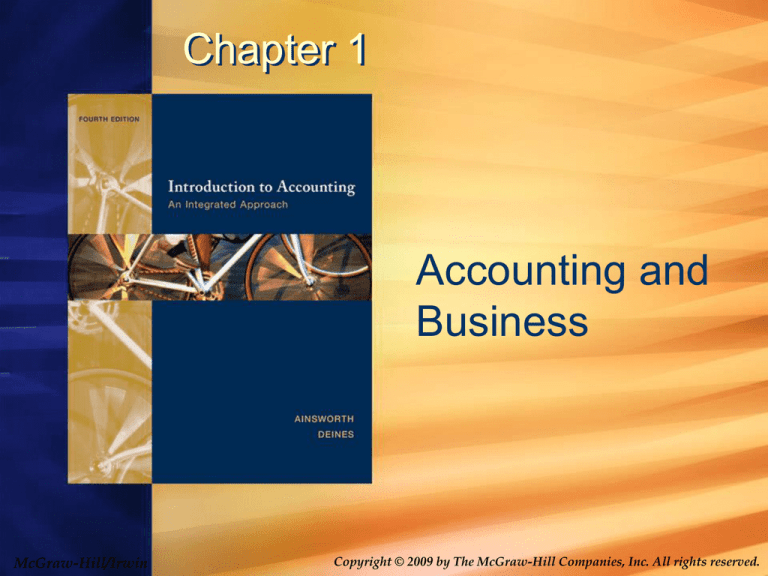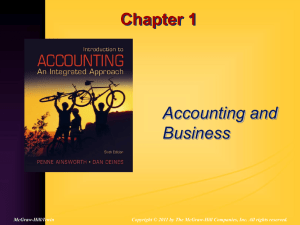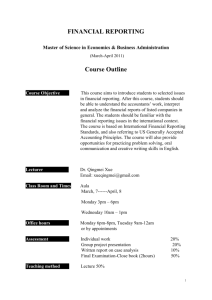
Chapter 1
Accounting and
Business
McGraw-Hill/Irwin
Copyright © 2009 by The McGraw-Hill Companies, Inc. All rights reserved.
What are the Basic Functions of
Business?
•
•
•
•
•
Marketing
Human resources
Production and operations
Finance
Accounting and information systems
(In Teams determine the functions of each
of these and then how they use accounting
information—page 3.)
1-2
How do the Functions Use
Accounting Information?
• Marketing
Pricing, distribution costs
• Human resources
Pay and fringe benefits, hiring costs
• Production and operations
Production costs—actual and budgeted
• Finance
Cost of borrowing, benefits expected from
using the money
1-3
How has Business Evolved?
• Sole proprietorship
One owner
• Partnership
Two or more owners
• Corporation
Many owners
• Merchandising
Buy and sell products
• Service
Provide service
• Manufacturing
Make and sell products
What is Apple?
1-4
How has Accounting Evolved?
• Determination of wealth
What am I worth today
• Determination of income
How has my wealth changed
• On-going success
How is the business doing
1-5
Trivia Question +1
Al Capone, the infamous Chicago mobster,
was actually brought to justice not for murder,
but for what? +1
Tax Evasion
Elmer Irey, a forensic accountant caught him! He put
together enough evidence from Capone’s bank statements
and other financial records to indict him on income tax
evasion for which he was subsequently sentenced to prison.
1-6
What are the Characteristics of
Business Today?
• Customer-focused operations
• Global markets
• Manufacturing and Communications
Advances
• eBusiness
• Hybrid organizational structures
1-7
What are the Basic Concepts of
Accounting?
• Business entity
Keep business and personal records separate
• Monetary unit
Maintain business records in currency
• Going concern
Business will continue past the current period
• Periodicity
Profits/losses must be determined periodically
1-8
Cash vs. Accrual Accounting
• Cash basis accounting
Income is measured as the difference between
cash received from customers and the cash
paid to employees and other suppliers of goods
and services
• Accrual basis accounting
Income is measured as the difference between
sales (revenues) earned and the expenses
incurred during the period, regardless of when
cash is paid or received
What are the 5 Basic Elements of
Accounting?
• Asset
Right to use resources with future benefit
• Liability
Obligation to transfer resources in the future to
suppliers of goods and services
• Owners’ equity
Net assets belong to owners
1-10
5 Basic Elements Continued
• Revenues (accrual basis)
Amounts earned from providing goods
and services
• Expenses (accrual basis)
Amounts incurred in an attempt to
generate revenues
1-11
What is __________?
• Generally accepted accounting principles
• Financial Accounting Standards Board
Current rule-making body
Pronouncements – Statements of Financial
Accounting Standards
Statements of Financial Accounting Concepts
GAAP
1-12
What are the Concepts Statements?
• Concepts Statement #1
Useful information for decision making
• Concepts Statement #2
Characteristics of accounting information
(benefits>costs; materiality, understandability,
usefulness)
• Concepts Statement #3 (superceded)
• Concepts Statement #4
Objectives for non-business organizations
1-13
Concepts Continued
• Concepts Statement #5
What information should be presented in
financial statements and when that information
should be presented
• Concepts Statement #6
Elements of financial statements
• Concepts Statement #7
Estimating value of future cash flows
1-14
What Makes Information Useful?
• Relevance
Capable of making a difference in a decision
• Reliability
Dependable, must be verifiable, not biased
• Benefits > Costs
Benefits derived must be greater than cost
• Materiality
Large enough to have an impact on a decision
1-15
What are the 4 Basic Financial
Statements and Auditors’ Report?
• Income statement
Indicates revenues less expenses = net income
for a period of time
• Statement of cash flows
Indicates cash inflows and outflows from
operating, investing, and financing activities for
a period of time
• Statement of owners’ equity
Indicates changes in owners’ equity for a period
of time
1-16
Financial Statements Continued
• Balance sheet
Indicates the ending balances of assets,
liabilities, and owners’ equity at a point in time
• Auditor’s report
Indicates whether the company followed GAAP
when preparing its financial statements
1-17
What are the Purposes of the
Ratios?
• Current Ratio
Current Assets/Current Liabilities
Relationship between current
assets and current liabilities
1-18
What are the Purposes of the
Ratios?
• Debt to Equity Ratio
Total Debt/Total Shareholders’
Equity
Relationship between liabilities
and owners’ equity; measure of
company solvency (ability to pay
both short- and long-term
obligations)
1-19
What are the Purposes of the
Ratios?
• Return on Sales
Net Income/Sales
Relationship between net
income and sales; measure of
profitability (ability to generate
profit from sales)
1-20
Lecture Examples
1. A company provided $120,000 of services during
the year. They received $100,000 from
customers. The company’s employees earned
$70,000 in wages, but due to the way payroll is
determined (monthly), the employees were only
paid $55,000. What is the cash-basis income?
What is the accrual-basis income?
Answer:
Cash basis income:
Accrual basis income:
Lecture Examples
2.Describe each of the following items and
determine which financial statement it
appears on.
Accounts payable, $136
Building, $809
Accounts receivable, $876
Cash received from customers, $13,074
Cash paid for inventory, $8,338
Cash paid to employees, $1,724
Cost of goods sold, $8,192
Inventory, $908
Miscellaneous operating expenses, $3,686
Sales, $13,353
Wage expense, $1,750
Patent, $2
Long-term bank loan, $716
Common stock, $3,827
Retained earnings, $373
Cash balance, $2,211
Miscellaneous payables, $529
Lecture Examples
3.Using the amounts shown in Lecture
Example #2, calculate the current ratio, the
debt to equity ratio, and the return on sales
ratio.
Answer:
Current ratio:
Debt to equity ratio:
Return on sales ratio:





